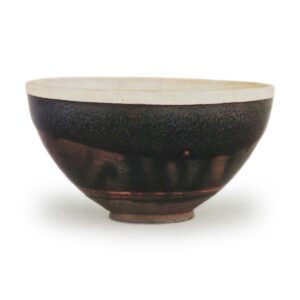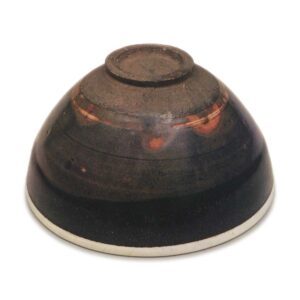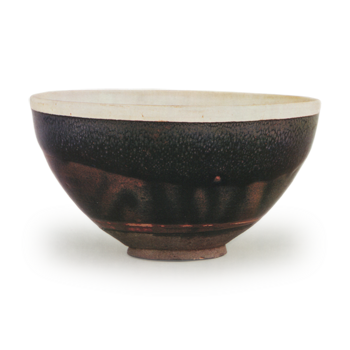

Important Cultural Property
Fujita Museum of Art
Height: 7.7-8.2cm
Bore: 14.9-15.0cm
Outer diameter of base: 5.0-5.2cm
Height of the same: 0.6cm
This is the same type of oily drip tenmoku as the previous piece, but instead of applying a metal rim, only the rim is covered with white makeup, and except for the white rim, the clay and glaze are almost the same as the previous piece. It is probably from one of the northern kilns. The use of the unique technique of white glaze and the tone of the white glaze suggest that it was made by a kiln in the Zizhou kiln family. The clay is supposed to have a whitish finish, and there are hints of this around the finger marks where the glaze has faded. The white glaze is hidden by the iron-rich clay coating on the part of the pot’s base that is to be used as a clay mirror. The Ryuuko-in and Fujita Museum of Art’s Yuridokitenmoku that appear later in this article also use this same type of painted clay. It is said that this was done in order to resemble the darker color of the original Jianyao clay.
The smooth, uncluttered shape of the bowl and the way the wide, outwardly stretched, ring-shaped base was cut are clearly in the style of the northern kilns. On a part of the side of the base, there are traces of a spatula from the scraping process. The glaze is also a double glaze, with an underglaze of iron mud similar to kimachi stone and a light-brown water glaze on top of it. Looking at the side wall of the side view, we notice that the upper half has a normal oil drop glaze, but the lower half has no oil drops and the color is shallow. This is because the water glaze on the upper half was applied over the under glaze more than in the case of the Tokugawa family’s oil drop tenmoku. Usagohozan oil drop and Yohhen star, which rarely appear in Tenmoku, are only produced when these two glazes overlap. In the case of Tatemoku from Kenkikama, there is no such mistake at all, so it can be said that the double-glaze mechanism is not obvious.
In this tenmoku, the outer glaze is poorly applied and the oil drippings are not very nice, but the inner surface is well prepared and beautiful. The deep sepia-toned black glaze is backed by a dense scattering of fine silver crystals. The glaze is slightly bubbled in the center of the prospect, and the grains are a little large, but the rest of the piece is a uniform oil droplet. However, similar to the Tokugawa Museum collection, there are few iridescence in this bowl. It is likely that the luster film was not applied in an ideal way due to the degree of glaze.
Lastly, let us mention the white covering. How was this applied? Common sense tells us that before glazing, white makeup is applied only to the rim, and then underglaze glaze is applied on top of it. Then, the underglaze is scraped off to the layer of white makeup only in the area of the current white covering to bring out the white color. After that, water glaze is applied to the entire surface and fired. However, when we look at this bowl, the outer white-covered surface is one level higher than the surface of the tenmoku glaze below. According to the technique described above, naturally, the white-covered part should be lower than the others, so it seems that some other method was used.
Since the white rim and the lower body of the bowl are tightly joined, the only way to do this would be to place a cord of soft clay on the rim of the bowl and shape it while turning the potter’s wheel to make it adhere to the rim of the bowl. However, the fatal flaw of this method is that the body of the bowl is dry and the string is wet, so the two do not fit together. The strings will eventually break here and there. I would even like to ask the artist of this work what is wrong with it.



